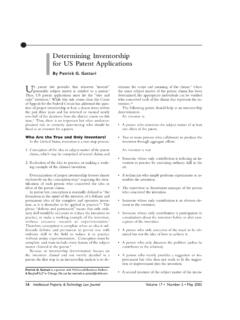Transcription of Materials Next Generation Science Standards
1 Bioenergy Education Initiative Advanced Hardwood Biofuels NW carbon footprint Page 1 carbon footprint Activity Objective Students will discover how their life choices influence their carbon footprint and how they can lower it. Skill Level: Middle school and high school Prep time: None Class time: 50 minutes Materials Computer with internet access Worksheet(s). See carbon footprint worksheet document. Next Generation Science Standards Disciplinary Core Idea: : Global Climate Change : Developing Possible Solutions Performance Expectations: MS-ESS3-5: Ask questions to clarify evidence of the factors that have caused the rise in global temperatures over the past century.
2 HS-ESS3-4: Evaluate or refine a technological solution that reduces impacts of human activities on natural systems. Practices Asking questions / defining problems Developing / using models Planning / carrying out investigations Analyzing / interpreting data Math / computational thinking Constructing explanations / design solutions Engaging in argument from evidence Obtaining / evaluate / communicate Crosscutting Concepts Patterns Cause and effect: Mechanism / explanation Scale, proportion, and quantity Systems and system models Energy / matter: Flows, cycles, conservation Structure and function Stability and change Bioenergy Education Initiative Advanced Hardwood Biofuels NW carbon footprint Page 2 Background Information Introduction Increasing global temperature is a serious challenge for our Generation and the generations to come.
3 The temperature of the earth s atmosphere has increased by F since 1900. Even though this change may seem insignificant, this temperature change is believed to already be causing climate change in some parts of the world. Steps can be taken to educate future generations on the many negative effects of global temperature increase and understand its potential causes. Scientists are trying to determine whether this increase is part of a natural cycle, or caused by human activity. Many scientists believe that increases in carbon dioxide in the atmosphere may be responsible for increasing temperatures. carbon dioxide is produced as a byproduct of burning fossil fuels, something that modern societies require.
4 This means that everyone has a carbon dioxide (or carbon ) footprint and it is highly dependent on lifestyle choices such as transportation, diet, and purchases. This activity will help students understand the effect of their life choices on their carbon footprint . It will also help them recognize the lifestyle choices available to them that would lower their carbon footprint . Additionally, students will also be asked to critically think whether the options for lowering their carbon footprint available are actions that they are willing to take. Background A carbon footprint is the amount of greenhouse gases (GHGs) an individual, system, or activity is responsible for releasing into the environment.
5 GHGs include carbon dioxide, methane, water vapor, ozone and nitrous oxide. These gases are needed in the atmosphere at their natural levels to regulate the earth s temperature and maintain life in our planet. These gases maintain some of the heat in the atmosphere that is radiated to the earth from the sun instead of letting it be released back into space. GHGs above normal levels may lead to more heat being trapped on the planet, which translates to climate change around the world. For example, 275 parts per million (ppm) of carbon dioxide (CO2) was present in the atmosphere until about 200 years ago. Scientists have develop models that indicate a safe upper limit is 350 ppm, but there is currently 400 ppm of CO2 in the atmosphere.
6 Furthermore, some of these gases remain in the atmosphere longer than others. Water vapor leaves the atmosphere every time it rains. Methane, which is primarily produced by livestock and fossil fuel production, can remain in the atmosphere for hundreds of years. The following diagram shows the greenhouse effect and the relative amounts of GHGs in the currently in the atmosphere. Bioenergy Education Initiative Advanced Hardwood Biofuels NW carbon footprint Page 3 Fig. 1 The relative amounts of GHG produced by human activities. Reference Diverse energy sources such as coal, petroleum, natural gas, hydroelectricity, solar, nuclear, and biomass have shaped our nation and played an important role in our development.
7 This development has come with a cost, and our nation, like many others, is dependent on fossil fuels for energy. These fossil fuels release high amounts of GHGs when burned for energy. We are releasing carbon dioxide and other GHGs into the atmosphere in a relatively short amount of time, while it took nature millions of years to sequester that energy in the form of coal, petroleum, and natural gas. Figure 2 demonstrates the lengthy process of creating coal. Bioenergy Education Initiative Advanced Hardwood Biofuels NW carbon footprint Page 4 Fig. 2 The process by which coal is produced.
8 Reference Nature does play an important role in sequestering carbon , but it can t keep up with our rapid burning of fossil fuels. Recent studies have showed that the natural processes for absorbing carbon dioxide are not keeping up with the increased rate of emissions. This leads to an accumulation of GHGs in the atmosphere. Three of our country s primary energy sources of our country petroleum, natural gas and coal are burned to produce energy. This energy is used to do work such as powering a TV or a game system, driving school buses, etc. This is why the amount of energy we consume greatly affects our carbon footprint . Household activities that produce a carbon footprint are those that require electricity, such as lighting, heating and cooling a house, showering, etc.
9 For most individuals, most GHGs are produced in an indirect way, like in the production of electricity to run appliances or transport goods. However, GHGs gases can also be produced directly when burning gasoline to fuel a car or burning wood in a fireplace for heat. A carbon calculator and lifestyle questionnaire estimate the amount of GHGs released over a period of time. Recognizing the amount of GHGs produced by the way we live our lives is an important step in stopping climate change. Knowing about the consequences of everyday actions will empower students to have a meaningful consideration of what they can do help combat climate change. Since there are various types of GHGs, for convenience, most carbon calculators convert all GHGs to carbon dioxide equivalents (CO2e), or the amount of CO2 that would cause the equivalent amount of damage as the other GHGs.
10 Bioenergy Education Initiative Advanced Hardwood Biofuels NW carbon footprint Page 5 Engage carbon emissions have dramatically increased over the past decades as nations such as China, India, and Brazil have become industrialized. Industrialized nations require more energy due to technological advances and economic prosperity. Goods that require energy, such as TVs, cars, and other appliances are more readily available to everyone. Industrialized nations house an increased amount of infrastructure such as roads, bridges and buildings that require large amounts of raw Materials and energy to build.










